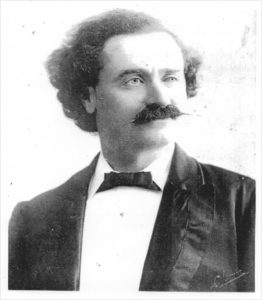Bragato Trust
Bragato Research Institute works closely with the Bragato Trust, a separate entity, to support each other’s objectives in education. The Trust provides scholarships in subjects of relevance to the viticulture and the wine industry, promoting the development and dissemination of viticulture knowledge and practice in New Zealand.
More information on the Bragato Trust can be found here on the New Zealand Winegrowers website.
Romeo Bragato
 Romeo Bragato trained at the highly regarded School of Viticulture and Oenology in Conegliano, Italy (1878 – 1883). He was the Victorian Government Viticulturist Expert from 1888 to 1901. Visiting New Zealand in 1895 and 1901, he moved across the Tasman in 1902 to serve as the New Zealand Government Viticulturist from 1902 to 1909.
Romeo Bragato trained at the highly regarded School of Viticulture and Oenology in Conegliano, Italy (1878 – 1883). He was the Victorian Government Viticulturist Expert from 1888 to 1901. Visiting New Zealand in 1895 and 1901, he moved across the Tasman in 1902 to serve as the New Zealand Government Viticulturist from 1902 to 1909.
He was escorted by Government officials from one end of the country to the other. His report, ‘Prospects of Viticulture and Instructions for Planting and Pruning’ submitted to the Premier on 10th September 1895 was reasoned and enthusiastic. Bragato strongly urged that associations be formed in the various districts, “A competent body in each district would determine the most suitable varieties for planting, collect and spread local data and thus in great measure secure the industry against failure. Each district would subsequently gain notoriety for the wine produced as in the famous districts of the Continent”.
He had found phylloxera in the Auckland vineyards of Mr Bridgman and Mr Harding of Mt Eden Road and strongly recommended an inspection of all vineyards. He also recommended the importation by the Department, from Europe, of cuttings of American resistant vines. Signor Bragato returned to Australia, leaving behind him a farming population excited by the prospects of wealth from viticulture. But two pests, Phylloxera and Oidium Mildew, and a lacklustre policy by the Department of Agriculture dampened the enthusiasm of most except the wealthy gentlemen farmers of Hawke’s Bay, the missionaries, and a new breed of wine growers entering the field, the Dalmatians.
In 1901 there was another flicker of interest by the New Zealand Government in viticulture and they asked Bragato to come back and report on the phylloxera which by now was having a heavy toll on the vineyards of the North Island, as it had done earlier in the vineyards of Europe. He had already given New Zealand the answer in his report of 1895 – root out the diseased vine, import and plant American resistant vines, (root stock grafted with European varieties). This time he was offered a permanent position and came back in 1902 to the newly created post of Viticulturist and Head of the Viticultural Division of the Department of Agriculture based at Te Kauwhata.
Bragato imported disease resistant stocks and in his handbook, Viticulture in New Zealand published in 1906 by the Department of Agriculture, showed growers how to graft the European classical varieties which predominated in the country at that time, on to the American root stocks.
Bragato’s work identified the varieties to plant, the Phylloxera resistant rootstocks to graft them to, the regions in which to plant vines, the varieties suitable to each region, vineyard layout, pruning methods and much more.
Regrettably his work was not acted on and lay forgotten for over 60 years. Dusted off by a few pioneers in the 1970s early 1980s, many of the recommendations of Romeo Bragato form the basis of modern New Zealand viticulture practices.




















